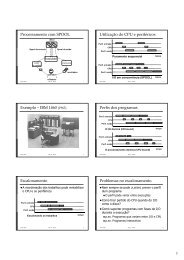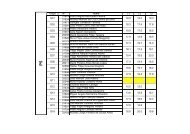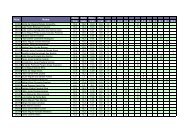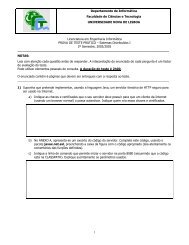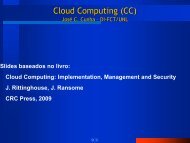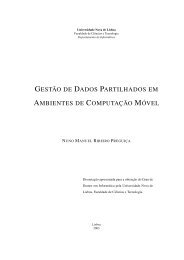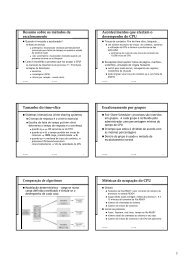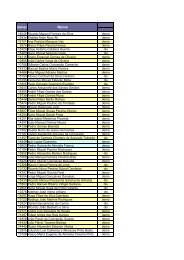Dissertaç ˜ao de Mestrado Mestrado em Engenharia Informática Jo ...
Dissertaç ˜ao de Mestrado Mestrado em Engenharia Informática Jo ...
Dissertaç ˜ao de Mestrado Mestrado em Engenharia Informática Jo ...
Create successful ePaper yourself
Turn your PDF publications into a flip-book with our unique Google optimized e-Paper software.
7<br />
Conclusion and Future work<br />
The concepts of virtualization and, more particularly, virtual appliance, rose to significant im-<br />
portance in the last few years. Virtualization allows for the consolidation of many un<strong>de</strong>ruti-<br />
lized servers into fewer machines, increased infrastructural utilization, easy replication and<br />
replication of virtual machines, among many other benefits. Virtual appliances are a conse-<br />
quence of the virtualization advanc<strong>em</strong>ents and refer to VMs composed solely of a minimal OS<br />
and a set of applications, optimized to perform a specific computational task.<br />
The VIRTU project is a collective effort by a consortium of enterprises and universities,<br />
whose objective is to <strong>de</strong>velop a platform for the creation and manag<strong>em</strong>ent of virtual appliances.<br />
Nowadays, the offering of virtualization solutions is increasing each day, but the configuration<br />
of virtual appliances is still a mainly manual task. Since a single machine tends to garner<br />
many VAs, configuring th<strong>em</strong> in an effective way has become a probl<strong>em</strong>. VIRTU tries to exploit<br />
this opportunity by offering on-<strong>de</strong>mand configuration of applications, in<strong>de</strong>pen<strong>de</strong>ntly of their<br />
vendor.<br />
This thesis tackles the probl<strong>em</strong> of automatic configuration of applications, regardless of<br />
their vendors, in virtual appliances. The automatic configuration of applications is important<br />
since it allows for the reduction of required time to configure applications. It assumes a special<br />
importance if we consi<strong>de</strong>r a business scenario, where much time is wasted in configuration du-<br />
ties. A hurdle for the application configuration, regardless of the vendor, is that nowadays, ap-<br />
plications already represent their configurations on wi<strong>de</strong>ly adopted standards, although many<br />
of those standards exist and the majority of the applications resort to vendor-specific formats.<br />
The aim of this work consists on creating a framework that allows the abstraction of the used<br />
formats, allowing for the configuration process to be the same for every application, as well as<br />
automating that process from it results the least human interaction.<br />
At first, two possible ways to <strong>de</strong>al with this subject were approached: configure the appli-<br />
79



